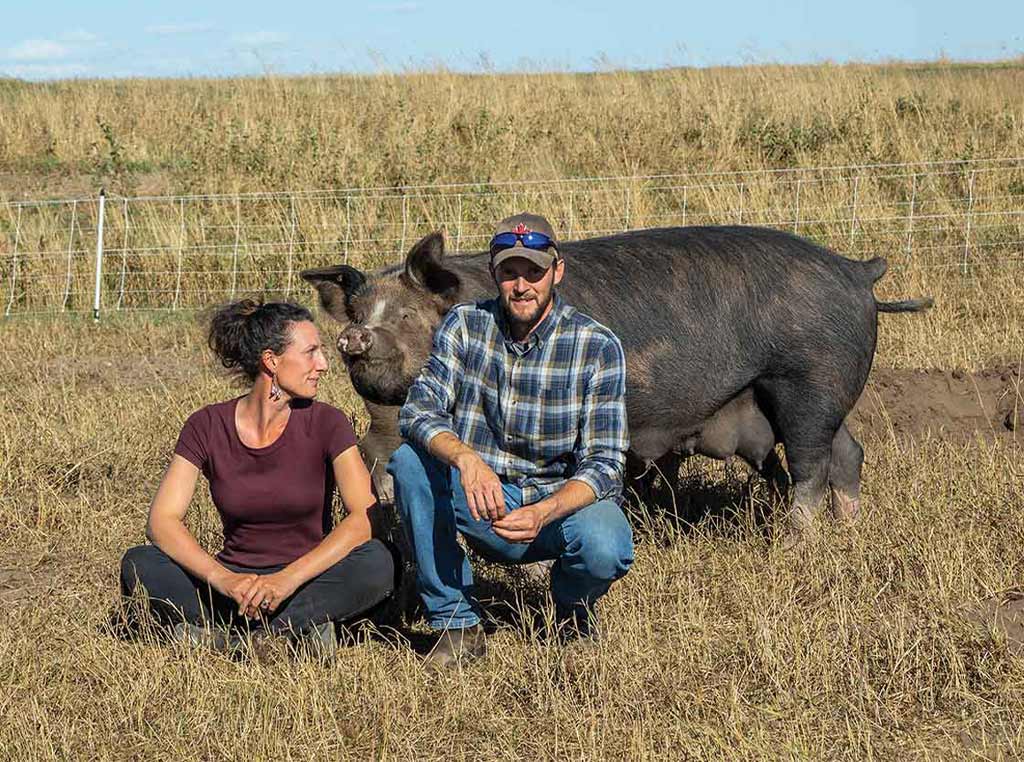
Jocelyn and Andre Voortman manage TK Ranch’s pasture pork operations.
Agriculture, Livestock/Poultry June 01, 2021
Pasture Pork
Raising pork under the open skies captures niche consumer market.
Do happy pigs taste better? The Biggs family, Dylan and Colleen, their daughters Julia, and Jocelyn and her husband Andre Voortman, with TK Ranch in Coronation, Alberta, thinks they do. That’s why their Berkshire and Duroc heritage breed hogs spend their entire lives out on pasture.
“Pigs are very intelligent with lots of personality,” says Jocelyn Voortman. “It’s easy to tell if they are happy, sad, or bored.”
Having room to run, play, root, and wallow in the paddocks gives them a much higher quality of life. It also injects much more variety in their diet.
Ric Pelkey, a self-proclaimed meat lover from Calgary, Alberta, doesn’t know a lot about raising farm animals, or the breeds of pigs TK Ranch are raising. But his taste buds tell him they’re doing something right.
“The pork is very flavorful and very tender,” Pelkey says. “I imagine it has a lot to do with how they’re treating the animals and the diet they’re eating. In the end, their pork is fantastic.”
The Biggs family have been raising beef in East Central Alberta since 1956 when Thomas Koehler Biggs, Dylan’s father, moved to the region from New York. In 1995, tight profit margins convinced Dylan and Colleen to try increasing the value of their animals by direct marketing grass-fed beef to consumers. Customer demand convinced them to add a pasture pork operation to the mix in 2010.
“Lots of people had lots of good reasons why you couldn’t raise hogs outdoors in East Central Alberta, but they decided to buy eight bred gilts and two boars anyway,” Voortman says. “We had 56 piglets the first year and now annually raise between 325 and 375 feeder hogs.”
Raising pigs on pasture on the Canadian Prairies was common before the Second World War, Voortman says. They knew it was possible if they could rediscover how it was done in the past.
“The biggest thing was to raise heritage breeds,” Voortman says. “They were bred to be raised outdoors and grow good coats of hair as soon as it starts to get cold.”
Farrowing doesn’t start until the beginning of April at TK Ranch when they know the piglets will be warm enough in the huts. It stops at the end of August; this ensures that even the youngest piglets will be large enough to thrive when colder weather sets in.

TK Ranch raises between 325 and 375 feeder hogs on pasture each year. Numbers are matched to sales. There is an unlimited market for bacon, and good demand for popular cuts like ribs and pork chops from grass-fed hogs. They carefully manage their ground pork inventory. Dylan Biggs says their on-farm abattoir was designed to minimize animal stress.
Once it does, the hogs shelter in large straw huts built with big square bales and wooden roofing. Windbreaks are placed in front of the entrances. As long as they’ve lots of straw bedding to burrow and snuggle up in and high energy feed, they’re perfectly fine in the harshest winter weather.
Sows average about eight piglets per litter. The Biggs quickly learned many sows don’t have good maternal instincts. This isn’t a concern in hog barns using farrowing crates, but it is when hogs are raised on pasture where sows have access to their piglets from the moment they’re born. So, they carefully monitor their gilts and sows to identify the best mothers. They only want to breed those capable of keeping their piglets alive when they’re alone with them in their pens.
“It’s important to train piglets to avoid an electric fence at a very young age,” Voortman says. “If they shock themselves on one within two or three days of being born, they’ll respect fences for the rest of their lives.” Piglets are weaned at eight to nine weeks and will normally finish between eight to nine months. All animals are then sold directly to consumers through their marketing programs.
“We built Canada’s only on-farm provincially licensed red meat abattoir in 2015 and now process 12 beef and eight hogs through it every week,” Voortman says. “We constructed a separate facility to cut, wrap and process our meat outside of Calgary at the same time. Our initial goal was to manage our costs and to eliminate the animals’ travel stress. But we quickly noticed that there were many benefits to being able to control, and absolutely guarantee, the quality of our products from pasture to plate.”
Since they had built their business model around selling frozen, grass-fed meats through their online sales portal they were well positioned for the surge in demand for them when the pandemic hit. Their online store sales exploded by 300 percent.
This degree of care and control matters to avowed carnivores like Pelkey. He knows what he looks for when he goes shopping. So, when a good friend suggested he check out the grass-fed beef and pasture pork products on TK Ranch’s website, www.tkranch.com, it revolutionized how he shopped for meats.
“There are tab menus for grass-fed beef, pasture-raised pork, grass-fed lamb, soy-free chicken and free-range turkey,” Pelkey says. Just click and order whatever you want. I follow the ketogenic diet so the first things I bought were their cottage pork chops; they were just what I was looking for. The first box of frozen products I ordered was so good I now buy all my meat from them. It’s a one stop place to shop for a meat eater, everything you need is right there.”

Having their own on-farm abattoir allows TK Ranch to control quality from pasture to plate. That matters because when consumers pay premium prices, they’re expecting to get quality products.
Read More

Rural Living, Specialty/Niche
Portrait of a Modern Homesteader
Living a long-held dream and scratching a living from the land.

